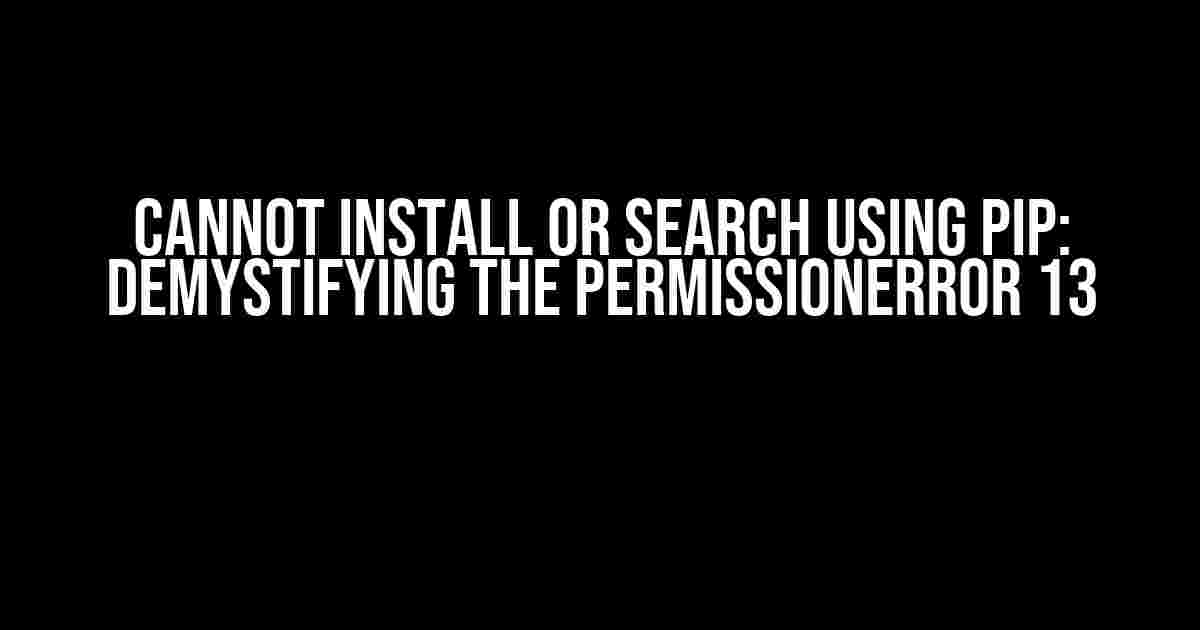Are you stuck in a pip-induced limbo, unable to install or search for packages due to the infuriating PermissionError 13? Fear not, dear developer, for we’re about to embark on a thrilling adventure to vanquish this error and get your pip workflow back on track!
- What is PermissionError 13?
- Solution 1: Run Pip with Elevated Privileges (sudo)
- Solution 2: Use the
--userFlag - Solution 3: Create a Virtual Environment (venv)
- Solution 4: Modify the Permission of the Package Directory
- Solution 5: Use pip with the
--no-cache-dirFlag - Troubleshooting Common Issues
- Conclusion
What is PermissionError 13?
Before diving into the solutions, let’s take a brief detour to understand the underlying issue. PermissionError 13, also known as EACCES (Error 13: Permission Denied), occurs when pip attempts to write to a directory or file that requires elevated privileges. This error is often encountered when using pip in a virtual environment or with system-wide packages.
Symptoms of PermissionError 13
When PermissionError 13 rears its ugly head, you might encounter the following error messages:
ProtocolError: PermissionError(13, 'Permission denied')Cannot uninstall 'package-name'. It is a distutils installed project and thus we cannot accurately determine which files belong to it which would lead to only a partial uninstall.
Solution 1: Run Pip with Elevated Privileges (sudo)
The simplest way to overcome PermissionError 13 is to run pip with elevated privileges using sudo. This approach is particularly useful when working with system-wide packages:
sudo pip install
sudo pip search
However, be cautious when using sudo, as it can lead to package inconsistencies and versioning issues. Proceed with caution and only use this method when necessary.
Solution 2: Use the --user Flag
A more elegant solution is to utilize the --user flag, which instructs pip to install packages in the user directory (e.g., ~/.local on Linux/macOS or %USERPROFILE%\AppData\Roaming\Python on Windows):
pip install --user
pip search --user
This approach is safer and more convenient, as it avoids system-wide package modifications.
Solution 3: Create a Virtual Environment (venv)
Virtual environments are an excellent way to isolate packages and avoid permission issues. Create a new virtual environment using:
python -m venv myenv
Activate the virtual environment (on Linux/macOS):
source myenv/bin/activate
On Windows:
myenv\Scripts\activate
Now, you can install packages without worrying about permission errors:
pip install
pip search
Remember to deactivate the virtual environment when you’re done:
deactivate
Solution 4: Modify the Permission of the Package Directory
In some cases, you might need to modify the permissions of the package directory to allow write access. This approach requires caution, as it can lead to security vulnerabilities:
sudo chown -R $USER ~/.local (on Linux/macOS)
On Windows, right-click the package directory, select Properties, and adjust the permissions accordingly.
Solution 5: Use pip with the --no-cache-dir Flag
In rare instances, the cache directory might be causing the PermissionError 13. Try running pip with the --no-cache-dir flag:
pip install --no-cache-dir
pip search --no-cache-dir
Troubleshooting Common Issues
Before we wrap up, let’s cover some common issues that might arise when dealing with PermissionError 13:
| Issue | Solution |
|---|---|
| pip is installed in a system directory | Use a virtual environment or install pip in a user directory |
| Package is installed globally | Use the --user flag or a virtual environment |
| Permission issues in a virtual environment | Check the virtual environment’s configuration and permissions |
Conclusion
In conclusion, PermissionError 13 can be a frustrating obstacle, but with these solutions, you should be able to overcome it and get back to developing with pip. Remember to always prioritize caution when working with system-wide packages and to explore the --user flag and virtual environments for a more efficient and secure experience.
Happy coding, and may the pip be with you!
Frequently Asked Question
Get the scoop on the most frustrating pip issue: “Cannot install or search using pip. ProtocolError: PermissionError(13)”.
Why do I get a PermissionError when trying to install a package using pip?
This error usually occurs when the Python executable or the package installation directory has restrictive permissions. Try running the command with administrator privileges or changing the permissions of the directory to allow writing.
Is there a way to avoid this error without using sudo?
Yes, you can! Instead of using sudo, you can create a virtual environment using `python -m venv myenv` and activate it. Then, you can install packages without requiring admin privileges.
What if I’m using a virtual environment and still getting this error?
Check if the virtual environment is activated correctly. If you’re still facing issues, try reinstalling the virtual environment or checking the permissions of the virtual environment directory.
Can I change the default installation directory to avoid permission issues?
Yes, you can! You can set the `PIP_USER` variable to install packages to a user-specific directory. For example, `pip install –user package_name`. This will install the package to the user directory instead of the system directory.
What if I’m still facing issues after trying all the above solutions?
Don’t worry! You can try reinstalling pip or seeking help from the community. Sometimes, it’s a bug or a specific issue with your system configuration. You can also try installing packages using a package manager like Homebrew (on macOS) or apt-get (on Ubuntu).





